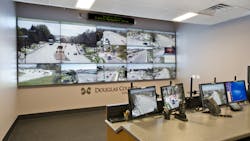High-quality video wall systems display a range of visuals and deliver eye-catching impact. Dealers and integrators are deploying these systems in a variety of applications, including: corporate boardrooms, military operations, digital signage, control rooms for critical infrastructure, security and surveillance monitoring, and law enforcement and emergency operations centers.
Creating or updating video wall systems requires the integration of many different underlying technologies to provide users with the best possible experience. With resolutions and bandwidth requirements steadily increasing, video processing equipment needs to leverage today’s evolving technologies while still accommodating the older, existing infrastructure.
Scalable and versatile, today’s video display systems are high-performance, cost-effective and easy to deploy in all types of situations from small-scale operations that use a multi-viewer on a single monitor, to enterprise-level video walls consisting of more than 100 monitors.
IP-enabled video wall display solutions and control room management systems enhance collaboration, operator awareness, and response times to improve health, safety and environment (HS&E) metrics.
Working with a design team that offers knowledge and expertise can help maximize the long-term returns of a video wall investment. While choosing the right media wall can be complex, these simple, but valuable tips will ensure a successful video wall system setup or upgrade.
1. Differentiate Between Wants & Needs
What a customer wants, and what they actually need can be very different things. Dealers and integrators should start the process by understanding how the customer will use the video wall today and its potential use in the future. During the design process, integrators must guide customers through a range of tradeoffs — such as needs today vs. needs tomorrow, costs, security and ease of use. Adding in some “bells and whistles” might fatten the integrator’s profit margin, but delivering a system with the functionality required and the ROI demanded will ensure a happy customer.
2. Understand Performance Expectations of the Product
It is important to ask specific questions around performance. The following questions will help integrators decide what kind of processor, cabling, extenders, signal support and connectors are needed:
- How many sources will feed into the video wall processor?
- What are their resolutions?
- What kind of content will be displayed?
- Will IP streaming sources or applications need to be displayed?
- How far away from the wall will the sources be located?
3. Clarify Number of Inputs, Outputs and Displays
Video wall processors configure multiple sources from disparate systems for display on an array of monitors or projector screens. Determine the size of the wall, the type of content (graphics, text, motion video or a combination), the number of sources that need to be displayed simultaneously, and whether real-time processing is required. For example, if the integrator chooses to build a video wall out of 2K HD displays, a 4K ultra high definition (UHD) processor still has value — a 2x2 array of HD displays is equal to a single UHD display. Typically, a variety of input signals will feed into a processor for display on a video wall, and these images may be spread out across multiple monitors. The pixel density of the input will determine how large it can be expanded on a video wall without negatively impacting clarity.
4. How Important is System Security?
Video walls can be used for a variety of applications, some mission-critical and some less so. Integrators need to understand and address the level of security that the central monitoring facility will need. For example, security is very important in control room, surveillance or monitoring environments, so a hardware-based video wall processor helps mitigate the risk of a data breach; however, for a less critical application where security is not a priority, such as digital signage, a PC-based system may provide more flexibility.
5. Design the System
With a clear idea of what’s to be expected, the integrator can now design the system. When possible, work with a manufacturer’s design services team, since they are experts in the use of their products. Ask for a system diagram, bill of materials, and a functionality statement that clearly outlines what the system was designed to do, what will be delivered, and the timeline for completing the project.
6. Build in Future-proofing
The technological landscape is constantly evolving. With this in mind, it is important to research trends and options that can enable future-proof installations. For example, you could build in room for system expansion, or enable the system to accommodate higher resolutions than are currently being used. Determine the most functionality and flexibility that the budget allows, and then decide which elements to incorporate.
7. Consider 4K Ultra High Definition (UHD)
4K UHD resolution offers considerable value in control room environments. Delivering 3840x2160 (8.3 million) pixels per display, it significantly enhances an operator’s ability to monitor finely detailed imagery; however, the limitations imposed by human vision raise some interesting questions about 4K deployment. What applications can benefit most from this higher pixel density and, by extension, in which situations is the incorporation of 4K UHD processing technology most effective?
8. Viewing Distance vs. Resolution
Human vision is confined to a narrow spectrum of wavelengths and resolutions. The eye is capable of resolving various densities and sizes of pixels, but this ability is greatly affected by the distance between the operator and display, the “viewing distance.” Display devices are available in a range of sizes — the smaller the screen or monitor, the more densely packed its pixels will be, and the closer the end-user would need to be to discern a visible difference between lower and higher resolutions. The display size and the typical viewing distance are two critical criteria that help determine the situations in which 4K UHD resolution adds value to an application.
9. Minimize Bezels
When constructing a multi-monitor video wall, another consideration is the total amount of continuous display space between monitor bezels. Bezels provide a rigid support structure for the panels (“glass”) in a display; however, on a video wall, bezels also break up the continuous appearance of images that may be scaled over multiple monitors. With a 4K UHD video wall, integrators can use larger format displays, reducing the number of bezels on the wall. If continuous imagery is important to an application, then 4K UHD resolution monitors offer this added benefit.
10. Plan for Video Wall Placement
If the customer needs to construct a video wall with the fewest bezels possible and the wall will likely be viewed from a maximum distance between 10 and 15 feet, then a very large-format 4K UHD display (84”-104”) may be the best fit for installation. In contrast, if the customer wants to use smaller monitors, and/or plan to view the wall from farther away, then 1080p displays may be a more cost-effective choice for the application.
11. Don’t Forget about Notable Exceptions
Some video wall applications are apparent exceptions to the guidelines above because they often require close-up inspection of ultra high-resolution imagery. These include: medical imaging; simulation modeling such as oil and gas exploration; manufacturing inspection systems; aerial reconnaissance; and megapixel surveillance. In these cases, users needing more visibility are likely to walk right up to a video wall, shortening their viewing distance of imagery so much that it makes sense to choose the highest resolution displays. 4K UHD processing equipment and video wall monitors are a logical choice in applications like these where minute details matter and video wall imagery may be subjected to close-up inspection.
12. Conduct a System Test Run
Before delivering the final product, thoroughly test and troubleshoot the system in-house. Take advantage of manufacturer training and on-site support to ensure the install will be smooth. This final step will increase user satisfaction with the system and reduce the time required for tech services personnel to be at the installation site; minimizing expenses. Leverage the expertise of a knowledgeable design team, gather information, manage expectations, and document every step before designing, testing and delivering the system.
John Henkel is Director of Product Marketing for RGB Spectrum. To request more info about the company, visit www.securityinfowatch.com/10214803.



